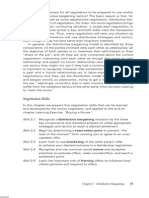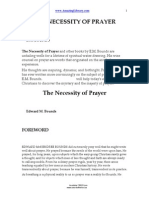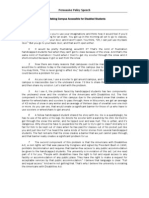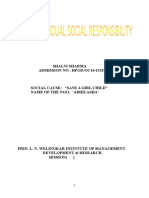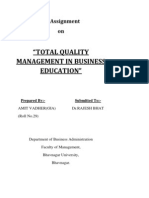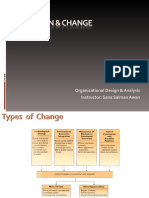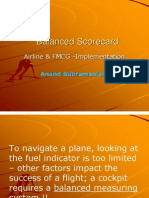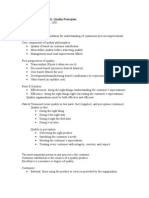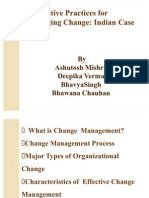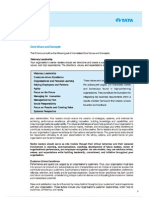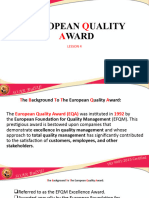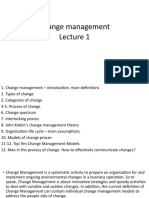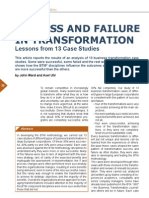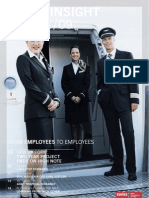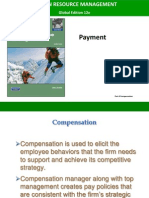Transforming Organizational Change
Transforming Organizational Change
Uploaded by
kary290790Copyright:
Available Formats
Transforming Organizational Change
Transforming Organizational Change
Uploaded by
kary290790Copyright
Available Formats
Share this document
Did you find this document useful?
Is this content inappropriate?
Copyright:
Available Formats
Transforming Organizational Change
Transforming Organizational Change
Uploaded by
kary290790Copyright:
Available Formats
Managing Change
Transforming Organizational Change
Managing Change
Presentation Coverage
Introduction Why Change ?
What is change Management ?
Types of Change Cultural Dimensions of Change
Typical forms of Teams in Change Management
Competencies important in the future IT to Manage Change Managing Change Implementation Steps Conclusion
2
Managing Change
Introduction - Why Change ?
Business Scenario in 1980s - 1990s..
1980s Scenario 1990s Scenario
Effective management of uncertainty
Managing Change
Introduction - Why Change ?
The pressures of todays business
We call these pressures the 3 Cs :
Customer, Competition,Change
Customer takes charge
Technology Product Variety /Quality / Reliabilty Delivery of products and services After Sales Service Customers Response Cost / Price
Competition Intensifies Constant Change (Political,Social (habits & preferences),Economic, Technological etc.)
Creating Pressure on organisations to change and bring continuous process improvements in
Managing Change
Introduction - Why Change ?
Business pressures
Customer Requirement
Fast Response Product Variety / Quality/ Reliability Low Cost Dependable Delivery After Sales Service
Leading to
Other Pressures
Import Restrictions Lifted
PROFIT
Taxes and Duties
CASH
Global Competition Product Alternatives
Restructuring - Radical and Drastic Strategic Alliance/ JVs Mergers and Acquisitions Bankruptcy
And yet there are companies which have emerged winners ...
5
Managing Change
Introduction - Why Change ?
How to run & win the race ?
Consistent IMPROVEMENT by understanding the OPPORTUNITY makes the difference
CHANGE
6
Managing Change
Change Management
What is Change Management?
Change management is the continuous process of aligning an organisation with its market place and doing it more responsively and effectively than competitors. Alignment is the continuous synchronization of four key management levers strategy, operations,culture, and reward. The organisation must accept the fact that change is going to happen and recur frequently. Its a reality. Change management must adapt a culture of Continuous Improvement Process (CIP) in terms of Cost,Quality & Delivery. Change Management should improve response time to customer for delivery of Product or service or complaint handling.
7
Managing Change
What is Change Management?
Types of change Structural Change Cost Cutting Change Process Change Cultural Change
Source: Managing Change & Transition , Harvard Business Essentials
Managing Change
What is Change Management?
Approaches to Change
Theory E Change Aims at maximizing
shareholder value
Theory O Change Aims at developing
organizational capabilities
Source: Managing Change & Transition , Harvard Business Essentials
Managing Change
What is Change Management?
Key Factors in Theory E and Theory O Change
Dimensions of Change Goals Theory E Theory O Theories E and O Combined
Maximize shareholder value Manage change from the top Emphasize structure and systems Plan and establish programs Motivate through financial incentives Consultants analyze problems and shape solutions
Develop organizational capabilities Encourage participation from the bottom up Build up corporate culture: employees behavior and attitudes Experiment and evolve Motivate thru commitment use pay as fair exchange Consultants support management in shaping their own solutions
Embrace the paradox between economic value and organizational capability Set direction from the top and engage the people below Focus simultaneously on the hard (structures and systems) and the soft (corporate culture) Plan for spontaneity Use incentives to reinforce change but not to drive it Consultants are expert resources who empower employees
Leadership Focus
Process Reward System
Use of consultants
Source: Michael Beer and Nitin Nohria, Cracking the code of Change, Harvard Business Review
10
Managing Change
What is Change Management?
Types of transformation
Planned
Internal Changes in products or services
Unplanned
Changing employee demographics
Changes in administrative Performance gaps system External Introduction of new technologies Government regulations
Advances in information processing and communication
External Competition
11
Managing Change
What is Change Management?
Why transformation
Market-driven, competitive environment
Winners and losers - ability to respond to the pace of change
Change happens - it just happens
12
Managing Change
Mckinsey 7s model for Strategic Management
2 Develop Strategy
7
Develop Systems for infrastructure 1
3 Design and develop Structure
Shared Vision
6 Define Style 5 Develop and acquire Skills 4
Staffing
13
4 MAJOR CULTURAL MODELS
The HAY CONSULTING GROUP has after substantial research in this area identified 4 major "cultural models" operating in organisations today.
These include the traditional, functional culture along with 3 newer evolving cultures: process, time-based and network. These cultures are driven and shaped by the 4 primary areas that organisations emphasize in order to achieve their desired results- Reliability, Customers, Flexibility and Technology. Note: Few organisations are however "culturally pure" . In most organisations there are variations and hybrids, such 14 as a process/time-based culture OR a time-based/network culture.
Managing Change
Cultural Dimensions of Change
4 MAJOR CULTURAL MODELS
I.The Functional Culture
1.Technology & Engineering
2.Reliability and quality
3.Customer needs 4.Flexibility and agility
15
Managing Change
CEO
Head of Marketing
Head of R&D
Head of Operations
Head of HR
Head of Finance
16
Managing Change
Cultural Dimensions of Change
4 MAJOR CULTURAL MODELS
II.The Process Culture
1. Customer Needs
2. Reliability and quality
3. Technology & Engineering 4. Flexibility and agility
17
PROCESS BASED ORGANISATION
( Process Matrix )
CUSTOMERS CORPORATE GOALS
ORDER OBTAINMENT GROUP
(Marketing)
ORDER FULFILMENT
(Supply Chain Group)
NEW PRODUCT DEVELOPMENT GROUP
(R&D)
PRODUCT MANAGEMENT GROUP
( 4 Ps Plus Interface with R&D, Field Sales Force, Production, QC, Processing, Packing & Distribution)
PEOPLE DEVELOPMENT PROCESS / PROGRAM
(Performance Management System, Compensation System, Reward Recognition System, Training & Development System, Talent Management, Competence Building, Leadership Development etc.)
FINANCE / ACCOUNTING
( Budgeting, Costing, Cash Flow,P & L, Balance Sheet, Taxation )
IT/ ERP
( MIS ,planning system, Order Processing, Inventory tracking system, delivery system 18 )
Managing Change
Typical forms of Teams in Change Management
PAT / CFT
Existing Organization Hierarchy
Team Elements
Directors / VPs / GMs
Corporate council
Managers
Support Services
Process Action Teams (PATs)
Workforce / staff
19
Managing Change
Total Employee Involvement
Mission Strategic Planning New Products
TOP
Management
Quality systems
MIDDLE
Task Force CFT/SIT QCC Facilitation DRAM QC Circles TEIAN 5S
Effective Communication is the key
SHOP FLOOR
FACT BASE EFFECTIVE UTILISATION OF PEOPLE POWER
20
Managing Change
Cultural Dimensions of Change
4 MAJOR CULTURAL MODELS
III.The Time-Based Culture
1. Flexibility and agility
2. Technology & Engineering
3. Customer needs 4. Reliability and quality
21
Managing Change
Cultural Dimensions of Change
4 MAJOR CULTURAL MODELS
IV.The Network Culture
1. Flexibility and agility
2. Customer needs
3. Technology & Engineering 4. Reliability and quality
22
Managing Change
Cultural Dimensions of Change Change Management
23
Managing Change
Cultural Dimensions of Change Change Management
Change Curve
Change
Performance
Objective
Current Valley of despair
Time
24
Managing Change
Some KEY elements of Work Culture
Maximising Customer Satisfaction Continuously improving operations Responding to customer feedback Acquiring cross-functional knowledge and skills Pushing decision-making to the lowest levels Encouraging creativity and innovation Encouraging training and learning (learning organization ) Treating employees fairly and consistently Encouraging Teamwork and two-way communication Providing secure employment etc. thru performance and accountability
25
Managing Change
Typical forms of Teams in Change Management
Team-type characteristics
Work Culture Team Type Parallel Attribute Commitment Duration Process Outcome Direction Skills Part-time Short / Long-term Individual Individual Diverse Full- time Full- time Process Project Functional
Quality First
Process
Time based
Permanent
Collective Shared Consolidate Process Skills
Long-term
Collaborative Shared Diverse Project related Skills
26
Functional Skills
Managing Change
Typical forms of Teams in Change Management
Why teams?
80%
70%
60%
50%
% of Respondents
40%
30%
20%
10%
0% Customer Satisfaction Product / Service Quality Productivity Staffing Flexibility
To Improve
Employee Satisfaction / Morale
27
Managing Change
TOTAL EMPLOYEE INVOLVEMENT (TEI)
BPI
HR
TEI
The ultimate success of a company in managing change depends on how it manages its human resource
Human beings have unlimited resources & immense capacities To develop human resources it is necessary to reinforce peoples positive assets
28
Managing Change
Competencies Important In the Future
COMPETENCIES IMPORTANT IN THE FUTURE
For Senior Management
Strategic thinking. The ability to understand rapidly changing environmental trends, market opportunities, competitive threats, and strengths and weaknesses of their own organizations, and to identify the optimum strategic responses.
Change leadership. The ability to communicate a compelling vision of the firms strategy that makes adaptive responses to stakeholders Relationship management. The ability to establish relationships with and influence complex networks of people who can be regarded as coequals or are internal or external business associates. The cooperation is needed for the organization to succeed.
29
Competencies Important In the Future
For Managers
Flexibility. The willingness and ability to change when needed organizations change strategies. to implement the Change implementation. Change leadership ability to communicate the organizations needs for change to co-workers; change management skills, including communication, training, and group process facilitation to implement change in discrete work groups. Entrepreneurial innovation. and production processes. The motivation to champion new products, services,
Interpersonal understanding. The ability to understand and value the inputs of diverse group of people involved in or impacted by the change process.
Managerial behaviors that are empowering. These include sharing information, participatively soliciting co-workers ideas, fostering employee development, delegating meaningful responsibility, providing feedback, expressing positive expectations of subordinates, and rewarding performance improvement. These steps make employees feel more capable and motivate them to assume greater responsibility. Team facilitation. Group process skills needed to get diverse groups of people to work together effectively to achieve a common goal.
Adaptability ,ability to adapt to any kind of change.
30
Managing Change
For Employees
Competencies Important In the Future
Flexibility . An example would be treating the adoption of a new technology
Motivation to seek information and ability to learn. Genuine enthusiasm for opportunities to learn new technical and interpersonal skills. Achievement motivation. The impetus for innovation and kaizen, which is the continuous improvement in quality and productivity needed to meet and preferably move ahead of ever-increasing competition. Work motivation under time pressure. A combination of flexibility, achievement motivation. Stress resistance, and organization commitment that enables individuals to work under increasing demands for new products and services in constantly shortening periods of time. This often is expressed as: I would best under pressure- the challenge really gets my juices flowing.
Collaborativeness. The ability to work cooperatively in multidisciplinary groups with diverse co workers.
Customer service orientation. A genuine desire to be help to others, interpersonal understanding sufficient to hear customers needs and the initiative to overcome obstacles in ones own organizations to solve customer problem.
31
Managing Change
IT to Manage Change
(For integration of HR systems)
(I) HUMAN RESOURCES INFORMATION SYSTEM (HRIS)
In the PAST
Employee profile Manpower Planning and Recruitment/ selection systems Training and Development systems Payroll systems etc etc.
TODAY...
Performance management systems
Compensation management systems Skill inventory and development
Comprising
of
Employee Database
Management Development Systems (Career and Succession Planning Focused systems )
on
Benchmarking best practices in industry EVA / ESOP modules Self-learning Desk (through Company Intranet for knowledge creation )
Why this?
Competitive advantage in business through people and processes
Benefits to the organisation
To attract and retain talent
Creation of invisible Assets for the organisation ( Eg. Cycle time reduction,Robust supply chain management, JIT etc etc. Flexibility in operations Creation of knowledge and skill based learning organisation Attainment of company goals
32
Managing Change
Managing Change - Implementation Steps
BASIC GUIDELINES DURING CHANGE
Following are eight guidelines for changing a corporate or team culture.
1. Have a good reason for making the change Culture changes are usually not fun. Take them seriously. Make sure you understand why you are making the change and that it is necessary. 2. Involve people in the change People who are involved are less likely to resist. Being a part of the planning and transition process gives people a sense control. Ask for opinions about how they would do it. Consider conducting surveys, focus groups and polls. 3. Put a respected person in charge of the process Each change needs a leader. Select someone who is seen in a positive light by the group.
33
Managing Change
Managing Change - Implementation Steps
BASIC GUIDELINES DURING CHANGE
4. Create transition management teams You need a cross-section of your group to plan, anticipate,troubleshoot, coordinate and focus the change efforts. You cant do it alone. 5. Provide training in new values, skills and behaviors People need guidance in understanding what the new way consists of and why it is more desirable. Training brings groups together; it allows them to express their concerns and reinforce newly skills. 6. Bring in outside help For some reason, there is often more power in what an outsider says than in the same suggestions coming from inside. Use this power to reinforce the direction in which you want to go. Outsiders bring important information and a fresh perspective.
34
Managing Change
Managing Change - Implementation Steps
BASIC GUIDELINES DURING CHANGE
7. Establish symbols of change Encourage the development of newsletters, new logos or slogans and / or recognition events to help celebrate and reflect the change. 8. Acknowledge and reward people As change beings to work, take time to recognize and recall the achievements of the people who made it happen. Acknowledge the struggle and sacrifices people have made.
35
Managing Change
Managing Change - Implementation Steps
Steps
Managing Change- Structuring the change Initiative
After carefully studying the need for change and identifying what has to changed an organisation should do the following
Change Readiness assessment Implementation Plan ( action plan, Major milestones, Responsibilities assignments, Completion date., cost / benefits Target etc.) Communication strategy / workshop Role of Sr.Management Steering / Monitoring committee Implementation Task Force. Building the change Process -Effective implementation -Ongoing Communication -Effective Management reporting Technology Support
36
Managing Change
Managing Change - Implementation Steps
Seven Steps to Implementing Change
1.Assemble a Change Management Team 2.Establish a New Direction for the Organisation 3.Prepare the Organisation for Change 4.Set Up Change Teams to Implement Change 5.Align Structure, Systems and Resources to Support Change 6.Identify and Remove Roadblocks to Change
7.Absorb Changes into the Culture of the Organisation
Source: Managing Organisational Change by V.Nilakant & S.Ramnarayan
37
Managing Change
Facilitating Organizational change
Sensitivity Training: Developing personal insight Survey feedback: Change by sharing information
Team building: Creating effective Work Groups
38
Managing Change
Managing Change - Implementation Steps
A. Redefining organisational strategy and goals. B. Re-engineering of core business processes
New Product Development process ( NPD)
So how do we manage change effectively ?
Order obtainment and fulfillment process (SCM)
People development process ( through right work culture / methods , competency building, employee development initiatives , compensation and rewards etc.) (PDP) Proper Integration of core processes through appropriate IT /ERP systems etc ( to create a database for on-line decision making. )
RESULTS IN
Increased efficiency in operations ( in terms of Cost,Quality and Delivery of product and services ) Increased Economies of scale (EOS) in operation Improved productivity of assets ( Man,Machine,Material and Money )
.. And thereby WINNING in the market place
Examples of Effective change managers : TVS Suzuki , GE, Sundaram Fasteners, Britannia etc.
39
Re-engineered HR System : A Conceptual Framework
Organisational purpose
How work is designed
Human Resources System
How people are selected / Nurtured / Developed
How people are rewarded
How performance is planned /Managed / Reviewed / Monitored
Integrated IT system
40
Managing Change
CONCLUSION
Creation of an organisation which has the elements of :
1. Organisational Learning 2. Continuous Improvement Process 3. Competitive Culture
41
Managing Change
For listening..
We believe in communicating & mutual learning.
42
You might also like
- Risk Assessment - Group A (GROCERY STORE)Document12 pagesRisk Assessment - Group A (GROCERY STORE)Eiron UnoNo ratings yet
- Change ManagementDocument9 pagesChange ManagementManish SinghNo ratings yet
- Comm 119 - Persuasive SpeechDocument5 pagesComm 119 - Persuasive SpeechLuis Fernando Morales100% (1)
- Negotiation SkillsDocument3 pagesNegotiation SkillscinthyuxNo ratings yet
- Worship Song: Bro. Dennis Opening Prayer: Sis. ImeldaDocument13 pagesWorship Song: Bro. Dennis Opening Prayer: Sis. ImeldaMylene VenturaNo ratings yet
- Necessity of PrayerDocument65 pagesNecessity of Prayersizquier66100% (1)
- Sample Persuasive Policy SpeechesDocument12 pagesSample Persuasive Policy Speechescyspace100% (1)
- Save A Girl ChildDocument56 pagesSave A Girl Childniceprachi100% (1)
- Interest ArticulationDocument18 pagesInterest ArticulationTet DeleonNo ratings yet
- PoliticsDocument3 pagesPoliticsElena Gonzalez MarquezNo ratings yet
- Chapter 14 Notes PDFDocument8 pagesChapter 14 Notes PDFIrish MagbanuaNo ratings yet
- Lecture 5 - Total Quality ManagementDocument54 pagesLecture 5 - Total Quality ManagementWAN ADLI WAN SHARIFUDZILLAHNo ratings yet
- Lecture 5 - Total Quality ManagementDocument54 pagesLecture 5 - Total Quality ManagementUMMI KALTHOM NABILAH ISMAILNo ratings yet
- SIX SIGMA in EducationDocument17 pagesSIX SIGMA in EducationVadher AmitNo ratings yet
- Strategic HR For Value CreationDocument17 pagesStrategic HR For Value CreationNishanth KrishnanNo ratings yet
- Organizational Design & StructureDocument27 pagesOrganizational Design & Structurekary2907900% (1)
- ADL 16 Total Quality Management V2 PDFDocument17 pagesADL 16 Total Quality Management V2 PDFGurbinder JaspalNo ratings yet
- TQMDocument65 pagesTQMAnilkumar Gopalan100% (3)
- Lecture 6-Principles of ManagementDocument22 pagesLecture 6-Principles of Managementsafdar2020100% (1)
- Block 5 MCO 1 Unit 1Document15 pagesBlock 5 MCO 1 Unit 1Tushar SharmaNo ratings yet
- Appy 5S PrceduresDocument14 pagesAppy 5S PrceduresEyosiyas DemissieNo ratings yet
- Lean Transformation A JourneyDocument29 pagesLean Transformation A JourneyMadhawa HabarakadaNo ratings yet
- Malcolm Brildrige ModelDocument72 pagesMalcolm Brildrige ModelMuhammad Nadeem Raza100% (1)
- Design For Quality An SME's Perspective: Dr. Abdul Raouf SIDocument17 pagesDesign For Quality An SME's Perspective: Dr. Abdul Raouf SILpitt56No ratings yet
- Change ManagementDocument52 pagesChange ManagementSuneeth VergheseNo ratings yet
- Strategic Management-Strategy and CultureDocument20 pagesStrategic Management-Strategy and CultureKuldeep Bartwal DeepNo ratings yet
- 3and4-Core Values and BEDocument12 pages3and4-Core Values and BEAnju SavithriNo ratings yet
- Core Values and ConceptsDocument3 pagesCore Values and ConceptsFaise RajputNo ratings yet
- Organizational Design & Analysis Instructor: Sana Salman AwanDocument15 pagesOrganizational Design & Analysis Instructor: Sana Salman AwanUsman AbbasNo ratings yet
- TQMDocument3 pagesTQMDINESH XpressNo ratings yet
- Balanced ScorecardDocument32 pagesBalanced ScorecardKapil Dhanania100% (1)
- Quality RevolutionDocument3 pagesQuality RevolutionEden AlayonNo ratings yet
- 2 Baldrige Criteria For Performance ExcellenceDocument5 pages2 Baldrige Criteria For Performance ExcellenceAnonymous HB7rTHGSNo ratings yet
- Invitation To Strategic Management: ObjectivesDocument35 pagesInvitation To Strategic Management: ObjectivesanashussainNo ratings yet
- Training & DevelopmentDocument72 pagesTraining & DevelopmentAmit MaharNo ratings yet
- Section 5-35 (Domain 3) : Quality PrinciplesDocument8 pagesSection 5-35 (Domain 3) : Quality Principlesapi-3828205No ratings yet
- Development of Quality CultureDocument18 pagesDevelopment of Quality Culturesuresh84123100% (1)
- Internal Scanning and Organizational AnalysisDocument40 pagesInternal Scanning and Organizational AnalysisJedNur KusayinNo ratings yet
- Module 1 TQMDocument12 pagesModule 1 TQMBaclayo Ay-AyNo ratings yet
- The Internal AssessmentDocument9 pagesThe Internal AssessmentFatimah Binte AtiqNo ratings yet
- Session I - The HR FrameworkDocument50 pagesSession I - The HR Frameworkkusumawi2311100% (2)
- Change Management 1Document50 pagesChange Management 1rocknroll_mahive1789No ratings yet
- OD & Global Supply ChainNOVDocument41 pagesOD & Global Supply ChainNOVDragos MacoveiNo ratings yet
- Quality ManagementDocument13 pagesQuality ManagementNandini MohapatraNo ratings yet
- Chapter 5 Business Process ChangeDocument33 pagesChapter 5 Business Process ChangeAllene MontemayorNo ratings yet
- TBEM Core Values & ConceptsDocument5 pagesTBEM Core Values & ConceptsSmita Dutt MitraNo ratings yet
- Organization Development Session 1: MethodologyDocument24 pagesOrganization Development Session 1: Methodologydevisoumyaja272No ratings yet
- Chapter TwoDocument46 pagesChapter TwoBahredin AbdellaNo ratings yet
- European Quality Award M4.Document34 pagesEuropean Quality Award M4.Rizzalyn ArriesgadoNo ratings yet
- Introduction To Strategic ManagementDocument47 pagesIntroduction To Strategic ManagementPeyush AgarwalNo ratings yet
- Integrated Management SystemDocument27 pagesIntegrated Management SystemAnudeep ChittluriNo ratings yet
- VP Continuous Improvement in Chicago IL Resume Mike MicklewrightDocument4 pagesVP Continuous Improvement in Chicago IL Resume Mike MicklewrightMikeMicklewrightNo ratings yet
- Strategic Quality PlanningDocument68 pagesStrategic Quality PlanningZiza Yusup100% (2)
- Introduction To Perfomance Improvement ProgrammesDocument17 pagesIntroduction To Perfomance Improvement ProgrammeskimenderoNo ratings yet
- 7CS6_QM_Notes (3)Document102 pages7CS6_QM_Notes (3)suryasaini427No ratings yet
- Four Levels of Quality: TQM 15.760 Total Quality ManagementDocument36 pagesFour Levels of Quality: TQM 15.760 Total Quality ManagementAbhishek PuriNo ratings yet
- Leading Organizational ChangeDocument47 pagesLeading Organizational ChangeTubagus Donny Syafardan100% (3)
- Change Management Lecture 1Document28 pagesChange Management Lecture 1rosine NdikubwimanaNo ratings yet
- Operations StrategyDocument42 pagesOperations StrategyKim Berly100% (1)
- Case Study On Product DissectionDocument6 pagesCase Study On Product Dissectionkary290790No ratings yet
- Article On BenchmarkingDocument10 pagesArticle On Benchmarkingkary290790No ratings yet
- Case Study 1 - Benchmarking at XeroxDocument3 pagesCase Study 1 - Benchmarking at Xeroxkary290790100% (1)
- Case Study 3 On Product BenchmarkingDocument3 pagesCase Study 3 On Product Benchmarkingkary290790No ratings yet
- Article On Benchmarking by Kenneth CrowDocument17 pagesArticle On Benchmarking by Kenneth Crowkary290790No ratings yet
- Organizational Design & StructureDocument27 pagesOrganizational Design & Structurekary2907900% (1)
- Article - Benchmarking IntroDocument5 pagesArticle - Benchmarking Introkary290790No ratings yet
- Organization Structure For Operations / Supply Chain ManagementDocument1 pageOrganization Structure For Operations / Supply Chain Managementkary290790No ratings yet
- Bosch IndiaDocument8 pagesBosch Indiakary290790No ratings yet
- Mailchimp Grants EmployeesDocument6 pagesMailchimp Grants Employeeskary290790No ratings yet
- 360 03 e Research Ward Uhl Success and Failure in Transformation 13 Case StudiesDocument8 pages360 03 e Research Ward Uhl Success and Failure in Transformation 13 Case Studieskary290790No ratings yet
- BOLD Talegaon InductionDocument13 pagesBOLD Talegaon Inductionkary290790No ratings yet
- Article On Benchmarking by Kenneth CrowDocument17 pagesArticle On Benchmarking by Kenneth Crowkary290790No ratings yet
- Culture Transformation Case StudyDocument10 pagesCulture Transformation Case Studykary290790No ratings yet
- FormatDocument2 pagesFormatkary290790No ratings yet
- HPK 3 Job Description Writing ToolDocument18 pagesHPK 3 Job Description Writing Toolkary290790No ratings yet
- ACCL15B - Advanced Accounting 1 & 2Document7 pagesACCL15B - Advanced Accounting 1 & 2cherry valeNo ratings yet
- Icmai Rvo: Continuing Education ProgrammeDocument37 pagesIcmai Rvo: Continuing Education ProgrammeChulbul PandeyNo ratings yet
- Introduction To Foreign Exchange MarketsDocument16 pagesIntroduction To Foreign Exchange MarketsMalik BilalNo ratings yet
- 660Document160 pages660Chris ParkinsonNo ratings yet
- Alan Shapiro and Peter Moles: International Financial Management 1st Edition John Wiley & Sons, IncDocument29 pagesAlan Shapiro and Peter Moles: International Financial Management 1st Edition John Wiley & Sons, Incdini6483No ratings yet
- The Main Principles of Total Quality Management: Andrei DiamandescuDocument7 pagesThe Main Principles of Total Quality Management: Andrei DiamandescuipraoNo ratings yet
- Tutorial 7 Questions (Chapter 3)Document13 pagesTutorial 7 Questions (Chapter 3)tan JiayeeNo ratings yet
- Final Term PaperDocument29 pagesFinal Term PaperСофия КалюжнаяNo ratings yet
- Introduction To Organizational Behavior Learning ObjectivesDocument10 pagesIntroduction To Organizational Behavior Learning ObjectivesNahia ĐoànNo ratings yet
- ZONIQ ProfileDocument13 pagesZONIQ Profileaaui.ginaNo ratings yet
- Assignment - Baseline DataDocument3 pagesAssignment - Baseline DataBea BalaoroNo ratings yet
- Macroeconomics 8th Edition Abel Test Bank 1Document12 pagesMacroeconomics 8th Edition Abel Test Bank 1todddoughertygswzfbjaon100% (46)
- Case 4-3 - SIM-F-Klp-7Document5 pagesCase 4-3 - SIM-F-Klp-7Ilham DevaNo ratings yet
- ITIL Management OverviewDocument23 pagesITIL Management OverviewIqbalurNo ratings yet
- SWISS Insight Winter 09Document24 pagesSWISS Insight Winter 09soltoc100% (1)
- PT4138Document16 pagesPT4138Mahesh SharmaNo ratings yet
- Artist Management for the Music Business Paul Allen All Chapters Instant DownloadDocument55 pagesArtist Management for the Music Business Paul Allen All Chapters Instant Downloadzupkocihonm7100% (2)
- MGT301 Midterm MegaDocument131 pagesMGT301 Midterm MegaAmjad AliNo ratings yet
- A Study On Portfolio Analysis of Banking sector1Document110 pagesA Study On Portfolio Analysis of Banking sector1Nexgen TechnologyNo ratings yet
- MC 402 Human Resource Management 61011405Document3 pagesMC 402 Human Resource Management 61011405komalkataria2003No ratings yet
- Bba3 Semester Bba-303: Cost Accounting: (2) Attempt Any One Question From Each Unit in Section BDocument2 pagesBba3 Semester Bba-303: Cost Accounting: (2) Attempt Any One Question From Each Unit in Section Brohit chatterjeeNo ratings yet
- Interview Qs On r12 p2pDocument15 pagesInterview Qs On r12 p2pAmitPradhanNo ratings yet
- DP 050T00A ENU TrainerHandbookDocument217 pagesDP 050T00A ENU TrainerHandbookLOBITOMIKY100% (1)
- Name:Nabila Sedki 51800015 Subject: Principles of Management Assignment: Six Principals of Effective Global Talent ManagementDocument4 pagesName:Nabila Sedki 51800015 Subject: Principles of Management Assignment: Six Principals of Effective Global Talent ManagementNabila SedkiNo ratings yet
- I. The Company: A. Company Background 1. Industry Affiliation and Start of OperationDocument82 pagesI. The Company: A. Company Background 1. Industry Affiliation and Start of OperationQuốc Tuấn BùiNo ratings yet
- Trims and International ContractsDocument63 pagesTrims and International ContractsKristina JamiasNo ratings yet
- Chapter 9 Human Resource ManagementDocument29 pagesChapter 9 Human Resource ManagementJonathanHindiNo ratings yet
- Gelinas - AIS Acquisition CycleDocument40 pagesGelinas - AIS Acquisition CycleValerie JuliaNo ratings yet
- Today.: Technology For The Next DecadeDocument26 pagesToday.: Technology For The Next DecadeBschool caseNo ratings yet



